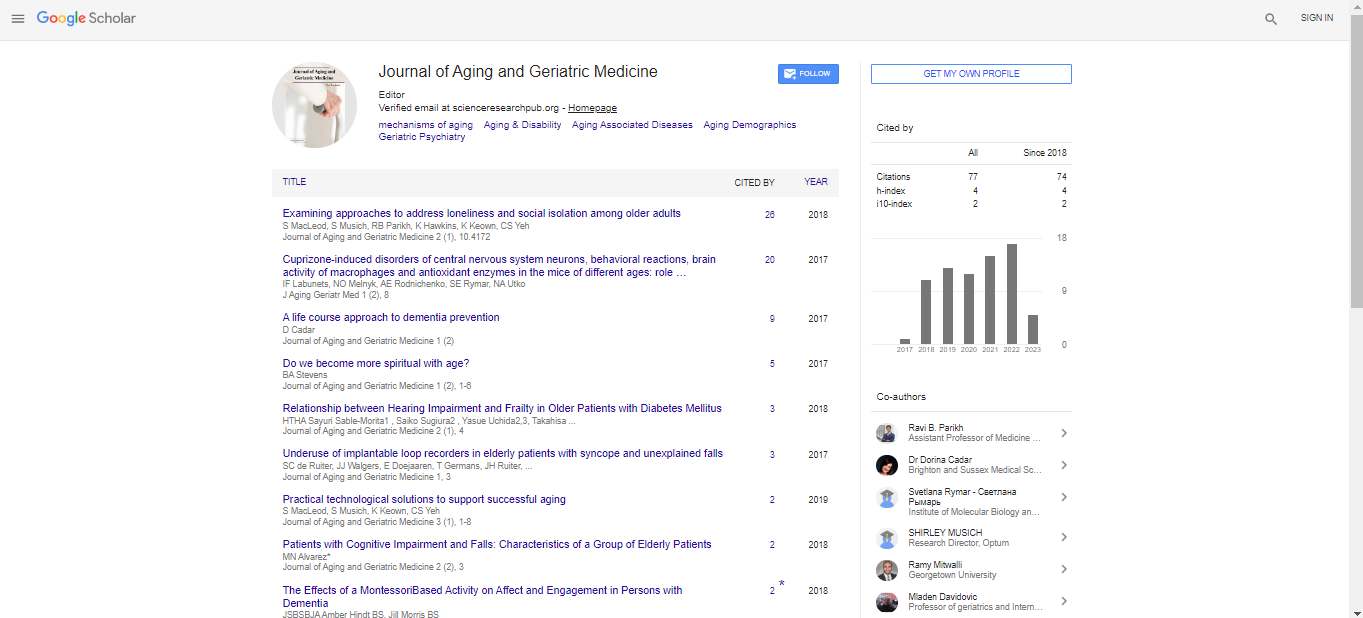Opinion Article, J Aging Geriatr Med Vol: 6 Issue: 3
A Review on Potential Pharmacotherapeutic Priorities
Urvashi Soni*
Department of Pharmacology, Institute of Pharm Research, GLA University, Mathura, India
*Corresponding author: Urvashi Soni
Department of Pharmacology, Institute of Pharm Research, GLA University, Mathura, India,
E-mail: urvashisonikorba@gmail.com
Received date: 03 March, 2022, Manuscript No. AGM-22-60786;
Editor assigned date: 05 March, 2022, PreQC No. AGM-22-60786 (PQ);
Reviewed date: 19 March, 2022, QC No AGM-22-60786;
Revised date: 24 March, 2022, Manuscript No. AGM-22-60786 (R);
Published date: 31 March, 2022, DOI: 10.4172/ ISSN: 2576-3946.1000135.
Citation: Soni U (2022) A Review on Potential Pharmacotherapeutic Priorities. J Aging Geriatr Med 6:3.
Keywords: Pharmacotherapeutic
Description
Madness, in particular, is a defining point of Alzheimer's and Parkinson's conditions. Because of the combination of motor and cognitive impairments, Parkinson's complaint madness (PDD) has a lesser impact on affected people than Alzheimer's complaint madness (ADD) andothers.However, the other members will suffer greatly in terms of social and occupational functioning, If one family member develops madness. Presently, no applicable treatment is available grounded on an examination of the absolute pathophysiology of madness. As a result, our ideal of current review encouraged to look for madness pharmacotherapy grounded on their pathogenesis. We totally searched electronic databases similar as PubMed, Scopus, and ESCI for information on the pathophysiology of demetia, as well as their treatment with allopathic and herbal specifics. By modulating intermediate proteins, oxidative stress, viral protein nimbus, and MMP9 are etiological factors that beget madness. The pathophysiology of ADD was described by two suppositions the amyloid waterfall thesis and the tau and distraction thesis. ADD is caused by an increase in amyloid-beta (Aβ) and neurofibrillary befuddlements in the mind. The viral protein nimbus (VPC) is more contagious and helps to form amyloid-beta (Aβ) pillars and neurofibrillary befuddlements in the mind. Thioredoxin interacting protein (TXNIP) inside the BBB encourages Aβ to come more engaged. PDD is caused by dropped or absent dopamine stashing from whim-whams cells in the substantia nigra, as well as PRKN gene omission/ duplication mutations, and shift in the PRKN-PACRG organisation, all of which are linked to ageing. This composition bandied the pathophysiology of madness, as well as a list of herbal specifics that can fluently cross the BBB and have a remedial effect on madness.
Practice Guidelines as Topic
Post-traumatic stress complaint( PTSD) is a current anxiety complaint that results in multiple disabling symptoms. Research into the underpinning neurobiology has intertwined dysregulation in multiple neurotransmitter systems including norepinephrine, serotonin, and glutamate as well as the hypothalamic – pituitary axis. Understanding how these natural systems interact with each other and how they may affect crucial neural structures, similar as the amygdala, hippocampus, and prefrontal cortex, to producepost-traumatic symptoms is critical for the development of effective pharmacological treatments. We compactly bandy the proposed natural dysfunctions underpinning PTSD and how agents that target these dysfunctions may be employed in PTSD. We also give a review of the different pharmacological agents that have been delved in PTSD. These medicines include antidepressants,anti-adrenergic agents, anticonvulsants, benzodiazepines, atypical antipsychotics, and new agents.
Drug operation is getting decreasingly challenging for aged people, and there's limited substantiation to guide drug defining and administration for people with multimorbidity, frailty, or at the end of life. Presently, there's a lack of clear exploration precedences in the field of senior pharmacotherapy. To address this issue, transnational experts from 5 exploration groups in senior pharmacotherapy and pharmacoepidemiology exploration were invited to attend the initial Optimizing Senior Pharmacotherapy through Pharmacoepidemiology Network factory. A modified nominal group fashion was used to explore and consolidate the precedences for conducting exploration in this field. Eight exploration precedences were illustrated quality of drug use; vulnerable patient groups; polypharmacy and multimorbidity; person- centered practice and exploration; deprescribing; methodological development; variability in drug use; and public and transnational relative exploration. The exploration precedences are bandied in detail in this composition with exemplifications of current gaps and unborn conduct presented. These precedences punctuate areas for unborn exploration in senior pharmacotherapy to ameliorate drug issues in aged people.
Drug Therapy Note
Guidelines pertaining to the use of pharmacotherapy, focusing on conditions described in National Health Priority Areas, were identified using databases (Medline, Google Scholar) and organisation websites (Department of Health and Ageing, National Heart Foundation, National Health and Medical Research Council). Guidelines were reviewed and qualitatively analysed to identify any references or definitions of ‘elderly’ persons. Among the 20 guidelines reviewed, 3 defined ‘elderly’ by chronological age (i.e., years since birth) while the remaining 17 guidelines did not define ‘elderly’ in any way. All 20 guidelines used the term ‘elderly’, whilst some guidelines provided age (chronological)-based dosage recommendations suggesting an ageist or generalist approach in their representation of ‘elderly’, for which rationale was seldom provided. Thematic analysis of the statements revealed five key themes regarding how ‘elderly’ was considered within the guidelines, broadly describing ‘elderly’ persons as being frail and with altered pharmacology. Some guidelines also highlighted the limited evidence base to direct clinical decisionmaking. A continuum of perceptions of ageing also emerged out of the identified themes.
Clinical practice guidelines currently do not adequately define ‘elderly’ persons and provide limited guidance on how to apply treatment recommendations to older persons. The representation of ‘elderly’ in guidelines needs to be less based on chronological age or generic definitions focusing more on establishing a direct link between an individual patient’s characteristics and the pharmacology of their prescribed medication. Clinical guidelines that do not offer any practical descriptions of the features of ageing that are specifically related to the use of pharmacotherapy, or how to assess these in individual patients, render decision-making challenging.
 Spanish
Spanish  Chinese
Chinese  Russian
Russian  German
German  French
French  Japanese
Japanese  Portuguese
Portuguese  Hindi
Hindi 